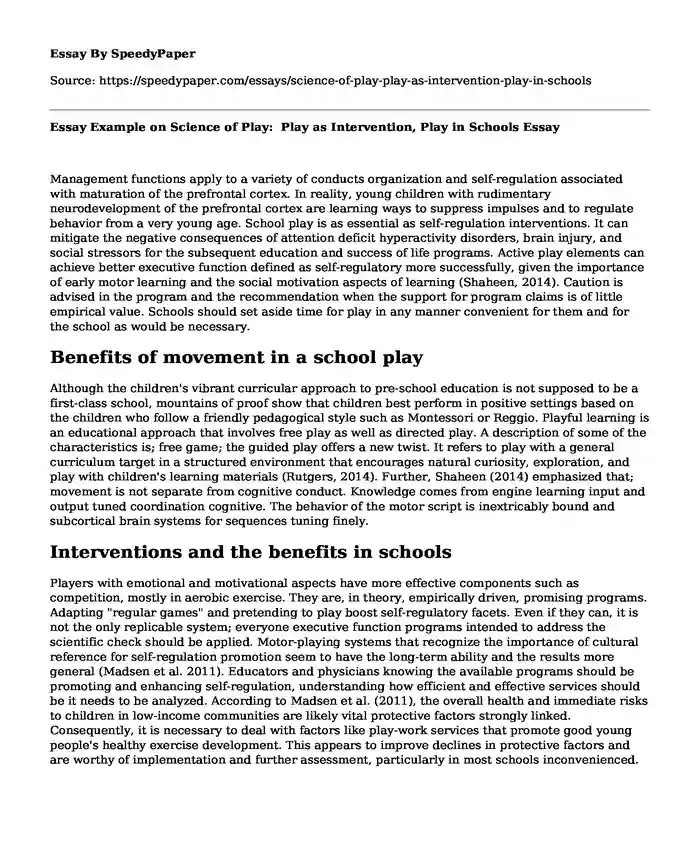
| Essay type: | Reflective essays |
| Categories: | Learning School Child development Behavior |
| Pages: | 3 |
| Wordcount: | 610 words |
Management functions apply to a variety of conducts organization and self-regulation associated with maturation of the prefrontal cortex. In reality, young children with rudimentary neurodevelopment of the prefrontal cortex are learning ways to suppress impulses and to regulate behavior from a very young age. School play is as essential as self-regulation interventions. It can mitigate the negative consequences of attention deficit hyperactivity disorders, brain injury, and social stressors for the subsequent education and success of life programs. Active play elements can achieve better executive function defined as self-regulatory more successfully, given the importance of early motor learning and the social motivation aspects of learning (Shaheen, 2014). Caution is advised in the program and the recommendation when the support for program claims is of little empirical value. Schools should set aside time for play in any manner convenient for them and for the school as would be necessary.
Benefits of movement in a school play
Although the children's vibrant curricular approach to pre-school education is not supposed to be a first-class school, mountains of proof show that children best perform in positive settings based on the children who follow a friendly pedagogical style such as Montessori or Reggio. Playful learning is an educational approach that involves free play as well as directed play. A description of some of the characteristics is; free game; the guided play offers a new twist. It refers to play with a general curriculum target in a structured environment that encourages natural curiosity, exploration, and play with children's learning materials (Rutgers, 2014). Further, Shaheen (2014) emphasized that; movement is not separate from cognitive conduct. Knowledge comes from engine learning input and output tuned coordination cognitive. The behavior of the motor script is inextricably bound and subcortical brain systems for sequences tuning finely.
Interventions and the benefits in schools
Players with emotional and motivational aspects have more effective components such as competition, mostly in aerobic exercise. They are, in theory, empirically driven, promising programs. Adapting "regular games" and pretending to play boost self-regulatory facets. Even if they can, it is not the only replicable system; everyone executive function programs intended to address the scientific check should be applied. Motor-playing systems that recognize the importance of cultural reference for self-regulation promotion seem to have the long-term ability and the results more general (Madsen et al. 2011). Educators and physicians knowing the available programs should be promoting and enhancing self-regulation, understanding how efficient and effective services should be it needs to be analyzed. According to Madsen et al. (2011), the overall health and immediate risks to children in low-income communities are likely vital protective factors strongly linked. Consequently, it is necessary to deal with factors like play-work services that promote good young people's healthy exercise development. This appears to improve declines in protective factors and are worthy of implementation and further assessment, particularly in most schools inconvenienced.
Conclusion
I would recommend that the Youth resilience approach involves physical exercise as a tool for promoting vital domestic and foreign asset development. It improves physical exercise well-being emotionally and protects against cardiovascular disease and obesity. At the same time, it can build natural social interaction opportunities that enhance robustness. Many physical activity programs with a youth framework, there is growth, and all are in favor of youth with low wages, but none are analyzed.
References
Madsen K, Hicks K, and Thompson, H (2011). Physical activity and positive youth development: Impact of a school-based program. J Sch Health 81(8). doi:10.1111/j.1746-1561.2011.00615.x. https://pubmed.ncbi.nlm.nih.gov/21740431/
Rutgers (2014). Playful learning: Where a rich curriculum meets a playful pedagogy. Available at http://nieer.org/2014/03/06/playful-learning-where-a-rich-curriculum-meets-a-playful-pedagogy
Shaheen S. (2014) How Child's Play Impacts Executive Function. Related Behaviors, Applied Neuropsychology: Child, 3:3, 182-187, DOI: 10.1080/21622965.2013.839612. https://www.tandfonline.com/doi/abs/10.1080/21622965.2013.839612
Cite this page
Essay Example on Science of Play: Play as Intervention, Play in Schools. (2023, Aug 27). Retrieved from https://speedypaper.com/essays/science-of-play-play-as-intervention-play-in-schools
Request Removal
If you are the original author of this essay and no longer wish to have it published on the SpeedyPaper website, please click below to request its removal:
- Academic Purpose - Application Essay Sample
- Essay Example on Tertiary Level Institutions Role
- Essay Sample on Orthopedic Impairements: Jane's Story
- Essay Sample on History of Deaf Education
- Essay Example. Professional Eportfolio
- Video Analysis Essay on Differentiated Reading Instructions
- Essay Sample on Saint Leo's Core Value of Integrity on Managerial Accounting
Popular categories




